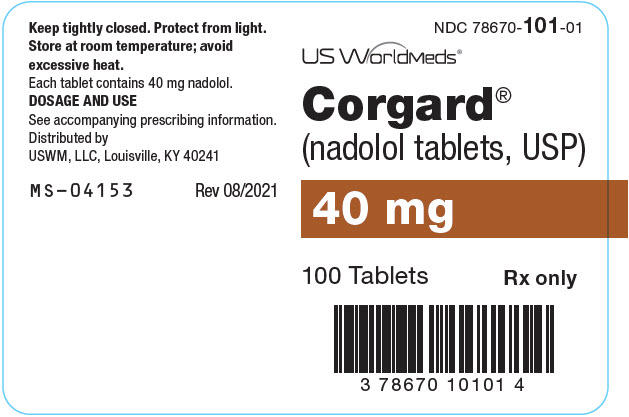Corgard
CORGARD TABLETS (nadolol tablets, USP)
c3c0fc03-7cca-4ac9-94b1-e3666470fe16
HUMAN PRESCRIPTION DRUG LABEL
Jul 21, 2023
USWM, LLC
DUNS: 117542566
Products 2
Detailed information about drug products covered under this FDA approval, including NDC codes, dosage forms, ingredients, and administration routes.
nadolol
Product Details
FDA regulatory identification and product classification information
FDA Identifiers
Product Classification
Product Specifications
INGREDIENTS (5)
nadolol
Product Details
FDA regulatory identification and product classification information
FDA Identifiers
Product Classification
Product Specifications
INGREDIENTS (5)
Drug Labeling Information
PACKAGE LABEL.PRINCIPAL DISPLAY PANEL
PRINCIPAL DISPLAY PANEL - 40 mg Tablet Bottle Label
NDC 78670-101-01
US WorldMeds®
Corgard®
(nadolol tablets, USP)
40 mg
100 Tablets
Rx only

INDICATIONS & USAGE SECTION
INDICATIONS AND USAGE
Angina Pectoris
CORGARD (nadolol) is indicated for the long-term management of patients with angina pectoris.
Hypertension
CORGARD (nadolol) is indicated for the treatment of hypertension, to lower blood pressure. Lowering blood pressure reduces the risk of fatal and nonfatal cardiovascular events, primarily strokes and myocardial infarctions. These benefits have been seen in controlled trials of antihypertensive drugs from a wide variety of pharmacologic classes including the class to which this drug principally belongs. There are no controlled trials demonstrating risk reduction with CORGARD.
Control of high blood pressure should be part of comprehensive cardiovascular risk management, including, as appropriate, lipid control, diabetes management, antithrombotic therapy, smoking cessation, exercise, and limited sodium intake. Many patients will require more than one drug to achieve blood pressure goals. For specific advice on goals and management, see published guidelines, such as those of the National High Blood Pressure Education Program's Joint National Committee on Prevention, Detection, Evaluation, and Treatment of High Blood Pressure (JNC).
Numerous antihypertensive drugs, from a variety of pharmacologic classes and with different mechanisms of action, have been shown in randomized controlled trials to reduce cardiovascular morbidity and mortality, and it can be concluded that it is blood pressure reduction, and not some other pharmacologic property of the drugs, that is largely responsible for those benefits. The largest and most consistent cardiovascular outcome benefit has been a reduction in the risk of stroke, but reductions in myocardial infarction and cardiovascular mortality also have been seen regularly.
Elevated systolic or diastolic pressure causes increased cardiovascular risk, and the absolute risk increase per mmHg is greater at higher blood pressures, so that even modest reductions of severe hypertension can provide substantial benefit. Relative risk reduction from blood pressure reduction is similar across populations with varying absolute risk, so the absolute benefit is greater in patients who are at higher risk independent of their hypertension (for example, patients with diabetes or hyperlipidemia), and such patients would be expected to benefit from more aggressive treatment to a lower blood pressure goal.
Some antihypertensive drugs have smaller blood pressure effects (as monotherapy) in black patients, and many antihypertensive drugs have additional approved indications and effects (e.g., on angina, heart failure, or diabetic kidney disease). These considerations may guide selection of therapy.
CORGARD (nadolol) may be used alone or in combination with other antihypertensive agents, especially thiazide-type diuretics.
OVERDOSAGE SECTION
OVERDOSAGE
Nadolol can be removed from the general circulation by hemodialysis.
In addition to gastric lavage, the following measures should be employed, as appropriate. In determining the duration of corrective therapy, note must be taken of the long duration of the effect of nadolol.
Excessive Bradycardia
Administer atropine (0.25 to 1.0 mg). If there is no response to vagal blockade, administer isoproterenol cautiously.
Cardiac Failure
Administer a digitalis glycoside and diuretic. It has been reported that glucagon may also be useful in this situation.
Hypotension
Administer vasopressors, e.g., epinephrine or levarterenol. (There is evidence that epinephrine may be the drug of choice.)
Bronchospasm
Administer a beta2-stimulating agent and/or a theophylline derivative.
HOW SUPPLIED SECTION
HOW SUPPLIED
CORGARD Tablets (Nadolol Tablets USP) are available in bottles of 100 in the following strengths:
20 mg tablets (NDC 78670-100-01), imprinted CORGARD 20
40 mg tablets (NDC 78670-101-01), imprinted CORGARD 40
All tablets are scored (bisect bar) and easy to break. USWM is imprinted above the bisect bar.
STORAGE
Store at room temperature; avoid excessive heat. Protect from light. Keep bottle tightly closed.
